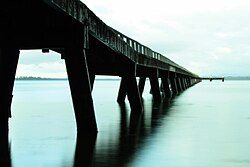Kauri Point | |
|---|---|
Rural settlement | |
 | |
 Interactive map of Kauri Point | |
| Coordinates: 37°30′43″S175°58′30″E / 37.512°S 175.975°E | |
| Country | New Zealand |
| Region | Bay of Plenty |
| Territorial authority | Western Bay of Plenty District |
| Ward | Katikati-Waihi Beach Ward |
| Community | Katikati Community |
| Electorates | |
| Government | |
| • Territorial Authority | Western Bay of Plenty District Council |
| • Regional council | Bay of Plenty Regional Council |
| • Mayor of Western Bay of Plenty | James Denyer [1] |
| • Coromandel MP | Scott Simpson [2] |
| • Waiariki MP | Rawiri Waititi [3] |
| Area | |
• Total | 0.27 km2 (0.10 sq mi) |
| Population (2023 Census) [5] | |
• Total | 186 |
| • Density | 690/km2 (1,800/sq mi) |
| Postcode(s) | 3170 |
Kauri Point is a rural settlement in the Western Bay of Plenty District and Bay of Plenty Region of New Zealand's North Island. It is on a headland on the eastern side of Tauranga Harbour, opposite Matakana Island. [6]
A coastal walkway through Kauri Point Historic Reserve connects Kauri Point to Ongare Point. [7] There are mature pōhutukawa trees and three pā sites in the reserve. [8] [9] A 200 metre long wooden jetty, built after 1947, provides fishing access to the harbour. [10] [11]
Dorothy Morris was a pioneer of the kiwifruit industry in New Zealand who she converted her dairy farm on Kauri Point Road to kiwifruit in the 1950s. [12]
George Vesey Stewart, who organised settlement of Katikati in the 1870s, initially planned for the town to be established at Kauri Point. [13] The settlement at Kauri Point did not eventuate until the 1970s. [14]
